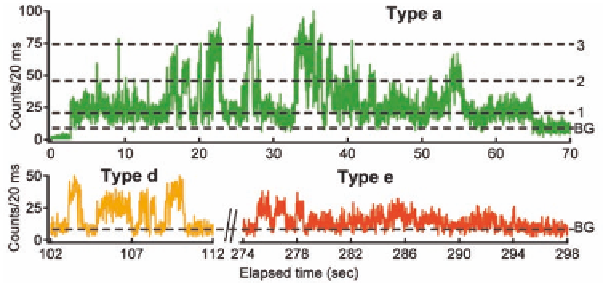Biology Reference
In-Depth Information
(unfolded) and red (folded) emission, respectively. In the unfolded
structures, quantum interactions between chromophores are not
established, so each perylene diimide functions as an individual
quantum emitter. In the folded structures, perylene stacks exhibit
strong quantum coupling through
π−π
molecular orbital overlaps,
which could either yield a Franck
Condon factor reversal or develop
into a delocalized exciton traveling across the
−
π
-stacks. As a result,
the folded structures function as a single collective quantum emitter
and yield only one characteristic in the time trajectories with one
spectral shape. This is further supported by the appearance of
photoblinking between on and off states in the yellow and red
emission regions.
Figure 5.25
Trimer (
) time trace collected simultaneously with spectra
showing three characteristic intensity regions and their
corresponding spectral types. ”Type a” emission showed
multilevel (1, 2, and 3) intensity jumps above background
(BG).
3A
Furthermore, two APDs were used to measure the emission
photons that were split into a green (<560 nm) and a red (>560 nm)
channel at 20 ms bin time. Because the red channel receives yellow,
orange, and red photons, various nongreen types switching (c, d,
and e) is difficult to be discriminated in the time traces. However,
pure green, type a, emission and spectral types with a very small
green component (types d and e) are readily observable in the time
traces. Two examples, one each for
4A
and
2
x
2
, are shown in Fig.
5.26. Concatenated foldamer
tends to exhibit steady-state-like
emission with very little switching. Thus, the green and red channels
are generally synchronized and rarely show regions where only one
2
x
2



Search WWH ::

Custom Search